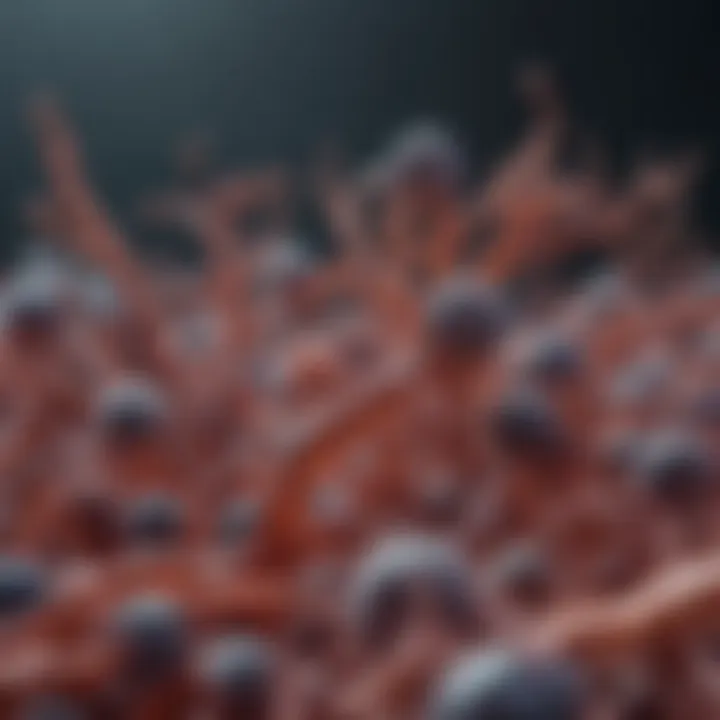Rab25 Antibodies: Key Players in Cellular Processes


Intro
The exploration of Rab25 antibodies provides a significant lens through which the dynamics of cellular biology can be fully understood. Working at the intersection of immunology and cellular processes, Rab25 plays a critical role in transportation, signaling, and overall cellular function. It acts as a small GTPase that influences various cellular mechanisms. As interest grows in this area, the associated antibodies have become not just mere tools for research but potential therapeutic agents in numerous diseases.
Research Overview
Key Findings
Recent studies have illuminated several vital roles that Rab25 antibodies play within the cellular environment. For instance, they have been linked to facilitating endocytosis and regulating various cellular signaling pathways. Their relevance has prominently surfaced in cancer research, where abnormal expression of Rab25 correlates with tumor progression and metastasis. The ability of Rab25 to influence intracellular trafficking highlights its importance in maintaining normal cellular operations. Moreover, there are indications that Rab25 antibodies may serve as biomarkers for certain disease states, helping in early diagnosis or tracking disease progression.
Study Methodology
The methodologies employed in researching Rab25 antibodies are as diverse as the cellular functions they impact. Common approaches include:
- Immunofluorescence: This technique allows researchers to visualize Rab25 localization and quantify its expression within cells.
- Western Blotting: Utilized for measuring the protein levels of Rab25 in various tissue types.
- Knockout Models: Genetically modified organisms are increasingly used to understand the functional roles of Rab25 and the effects of its antibodies.
These methodologies not only enrich our understanding but also enable potential pathways to therapeutic interventions.
Background and Context
Historical Background
The study of Rab proteins dates back several decades, but Rab25 has garnered interest particularly within the last twenty years. Initially characterized for its role in epithelial cells, researchers soon realized its far-ranging effects on other cell types, catalyzing a wave of investigations. Each insight has contributed a piece to the larger puzzle of cellular roles and disease implications.
Current Trends in the Field
With advancements in technology, the field is now seeing a noticeable shift toward the therapeutic potential of Rab25 antibodies. New research integrates cutting-edge methods like CRISPR for precision editing, aiding in the targeted study of Rab25's roles in diseases. Furthermore, collaboration across international labs has accelerated the pace of discovery, bringing together various disciplinary expertise to tackle complex biological questions.
"Understanding Rab25 is not just an academic pursuit; it holds the potential to redefine therapeutic strategies in cellular biology."
As we delve deeper into the role of Rab25 antibodies, we're stitching together a narrative that intertwines cellular mechanics with broader implications for health and disease. The urgency to comprehend these antibodies intensifies as we face an array of challenges in medical science and treatment options. Thus, this article serves as a clarion call for researchers, students, and educators to engage with the intricate and evolving world of Rab25 and its antibodies.
Intro to Rab25 Antibody
The study of Rab25 antibodies plays a significant role in the broader field of cellular biology. Understanding these antibodies offers critical insights into various cellular processes and how they interact with health and disease. The focus on Rab25 isn’t merely an academic endeavor; it unlocks doors to potential therapeutic strategies, particularly in cancer and other pathologies.
With Rab25 antibodies, researchers can delve into the complexities of intracellular signaling, growth regulation, and apoptosis. It’s like peering through a microscope at the intricate workings of cells, revealing not just the structures but the delicate interplay between them. Antibodies specific to Rab25 might just shine a light on pathways previously obscured, affecting how we approach disease treatment and diagnosis.
Basics about Rab25 antibodies are thus essential for anyone wishing to wade into the waters of cellular mechanisms.
Definition and Overview
Rab25 is a member of the Rab family of small GTPases, pivotal in regulating various components of cellular processes. Antibodies targeting Rab25 are tools developed to recognize and bind specifically to this particular protein. But it's not just about binding; it's about understanding what happens when these antibodies attach to Rab25 and how that influences cellular activity.
In research and clinical labs, Rab25 antibodies are tools enabling scientists and medical professionals to explore cellular dynamics in real time. For instance, these antibodies can be utilized in assays to assess the role of Rab25 in specific cellular contexts, be it in healthy cells or those undergoing transformations indicative of diseases. The well-crafted nature of these antibodies allows for high specificity, leading to more accurate results and insights.
Historical Context
The journey of understanding Rab proteins began decades ago, but Rab25 emerged more notably in recent years. It was first characterized amidst the increasing interest in the role of GTPases in cancer. Researchers realized that Rab proteins were not mere cellular components but active participants in vital processes.
As research unfolded, Rab25 was identified as particularly critical in processes like endocytosis and cellular trafficking. It's fascinating how, over years, scientists were able to map out the historical milestones—early 2000s studies began highlighting Rab25’s links to cancer, tying its activity to cell proliferation mechanisms. Over time, the focus shifted from simply understanding how it works to harnessing this knowledge through antibody development. This progression is what makes studying Rab25—along with its antibodies—so relevant today.
"The study of Rab25 is not just about proteins; it’s the key to understanding life at a cellular level."
In sum, Rab25 antibodies represent much more than just a byproduct of scientific inquiry; they exemplify the evolution of our understanding of cell biology and its translation into potential therapeutic applications. As we continue, exploring the structure, function, and applications of these antibodies will provide deeper insights into their role. Their historical context is a compelling background that sets the stage for their current importance in biochemical research.
Structure and Function of Rab25
Understanding the structure and function of Rab25 is pivotal for exploring its role in cellular biology. Rab25, an essential member of the Rab family of small GTPases, primarily governs vesicular trafficking processes within cells. Its structure comprises a unique configuration of domains that facilitate its interaction with various effector proteins, thereby enabling its regulatory roles. The intricate interplay of these components is crucial for maintaining cellular homeostasis and further emphasizes the significance of Rab25 in both normal and pathological states.
Molecular Composition
At the molecular level, Rab25 is characterized by its highly conserved GTP-binding domain and the switch regions essential for its GTPase activity. This GTPase cycle, which involves alternating between a GDP-bound inactive form and a GTP-bound active form, is central to Rab25's function. The protein's lipid-modified C-terminus is another noteworthy aspect; it plays a direct role in membrane attachment, allowing Rab25 to localize to specific cellular compartments, such as endosomes and the plasma membrane. This specific localization is crucial, as it determines the cellular areas Rab25 can effectively influence.
Role in Cellular Processes
Rab25's influence extends into multiple cellular processes that are foundational for maintaining a balanced cell life.


Intracellular Trafficking
Intracellular trafficking is a primary area where Rab25 shines. This process ensures that substances, such as proteins and lipids, are accurately sorted, packaged, and delivered within the cell. Rab25 orchestrates vesicle movement by recruiting motor proteins and organizing the fusion of vesicles to designated membranes. The ability to facilitate these interactions is a notable characteristic that strengthens Rab25's role in cellular logistics. A unique feature here is how Rab25 interacts with the cytoskeleton; through this connection, it aids in the directional transport of vesicles, effectively ensuring timely deliveries.
However, challenges may arise, such as potential mislocalization of vesicles that could lead to cellular dysfunctions and disorders.
Cell Proliferation
Cell proliferation is another dimension where Rab25 truly becomes pivotal. The protein has been shown to regulate the signaling pathways that control cell growth and division, linking execution to its trafficking capabilities. One significant beacon of Rab25’s role lies in its effect on integrins, which are key proteins that facilitate cell adhesion. By properly sorting receptors to the cell membrane, Rab25 maintains appropriate signaling pathways, thereby guarding against unchecked proliferation. Yet, an interesting note is that overexpression or dysregulation of Rab25 could push cells into overproliferation, stirring a variety of potential oncogenic pathways.
Apoptosis
Lastly, apoptosis, or programmed cell death, marks another critical arena where Rab25 exerts its influence. It plays a complex role in determining whether a cell continues to live or triggers its death mechanism. Through modulating the availability of certain receptors on the cell surface, Rab25 can indirectly influence the apoptotic signals received by cells. Its regulative participation in balancing survival and death underlines the importance of Rab25 in maintaining overall cellular health. This capability could lend itself to therapeutic avenues, particularly in cancer research; however, it poses a double-edged sword as malfunctioning apoptosis could lead to sustained cell life, contributing to tumor progression.
In overview, the multifaceted role of Rab25 through its structure and functional capabilities creates a profound impact on various cellular processes. Grasping these dynamics is vital for appreciating its biological significance, as it serves as a gateway to understanding the evolution of diseases and potential therapeutic strategies.
Rab25 Antibody: Generation and Characteristics
The journey of understanding the Rab25 antibody starts with how it's generated and characterized. This topic is vital because it shapes how researchers can utilize these antibodies for various applications in cellular biology. The choice of immunization strategy plays a key role in determining the efficacy and specificity of the antibodies produced. It’s not just about having antibodies at hand; it's about generating the correct ones that can accurately bind to Rab25 target molecules.
Immunization Strategies
Immunization is the process that prompts an immune response in animals, leading to the development of antibodies. When tackling the production of Rab25 antibodies, common practices include:
- Use of Specific Antigens: Typically, a recombinant form of the Rab25 protein is employed as an immunogen. This ensures the immune system recognizes the protein as foreign, eliciting an appropriate antibody response.
- Adjuvants: To enhance the immune response, adjuvants are often added. They bolster the body's response to the antigen. Options might include Freund’s complete adjuvant, which is effective but controversial due to ethical considerations in modern research practices.
- Select Species of Animal Models: Different animal models, such as rabbits or goats, are preferred based on the desired affinity and specificity of the antibodies. Larger animals often produce antibodies that are easier to purify.
Each of these strategies is crucial to ensure that the resulting antibodies are both robust and specific. The attention to detail in selecting these factors directly influences the quality of the generated antibody, paving the way for the next steps in the research process.
Antibody Purification and Characterization
After the antibodies are generated, they need to be purified and characterized. This step is not as simple as pouring the antibodies through a filter; it involves multiple methods to isolate the antibodies from other proteins in the serum. Common approaches include:
- Affinity Chromatography: Utilizing columns that are charged with the antigen of interest allows for specific binding of the antibodies. This technique exploits the high affinity between the antibody and its corresponding antigen.
- Ion Exchange Chromatography: This can also be employed to separate antibodies based on their charge characteristics. It’s highly effective, though more technical.
Once purified, it is essential to characterize the antibodies to assess their functionality and specificity. Techniques used for this purpose include:
- Western Blotting: This technique can determine the specificity of the antibody by checking its binding to the Rab25 protein. It displays the sizes of protein fragments, assisting in ensuring that the right antibody is selected for downstream applications.
- ELISA (Enzyme-Linked Immunosorbent Assay): Another robust method to verify antibody presence and quantify it. This assay exploits the binding affinity of the antibody to the antigen.
It is through these careful steps that researchers can ensure they have high-quality Rab25 antibodies, suitable for a range of applications from basic research to clinical diagnostics.
Together, immunization strategies and antibody purification form the backbone of any research involving Rab25 antibodies. They provide a foundation for future studies that can lead to breakthroughs in understanding cellular processes and disease mechanisms.
Applications of Rab25 Antibodies
The utilization of Rab25 antibodies extends far beyond the realm of mere laboratory tests; their applications are pivotal in various fields such as research, diagnostics, and therapeutics. By tapping into the unique attributes of these antibodies, scientists and medical professionals find opportunities to explore cellular mechanisms, identify diseases, and even tailor treatments. Understanding the significance of these antibodies helps frame their critical role in advancing cellular biology.
Research Applications
In the world of scientific exploration, Rab25 antibodies prove to be invaluable tools. Researchers employ these antibodies in various assays to probe the intricacies of cellular biology. Through immunohistochemistry, scientists can visualize the localization of Rab25 in tissue samples, providing insights into its role in health and disease. Moreover, these antibodies facilitate the study of intracellular dynamics, as they allow for the tracking of Rab25’s movement within cellular compartments.
- Key Highlights:
- Enable deep exploration of the Rab25 pathway.
- Assist in elucidating mechanisms involved in cell proliferation and survival.
- Contribute to understanding how Rab25 impacts diseases through experimental models.
Understanding the interplay between Rab25 and other cellular elements sheds light on potential pathological mechanisms. This comprehensive comprehension becomes a roadmap for further investigational studies that could lead to breakthroughs in treatments.
Diagnostic Uses
The inclusion of Rab25 antibodies in diagnostic settings holds significant promise. For instance, the expression levels of Rab25 can serve as biomarkers in identifying certain cancers. Elevated levels of Rab25 have been associated with tumor progression, making it a potential target for diagnostic testing. Additionally, these antibodies are instrumental in assessing the state of cellular health in patients with known conditions.
"Utilizing Rab25 antibodies as biomarkers can transform the approach to early disease detection."
- Diagnostic Benefits:
- Offer insight into disease progression.
- Aid in monitoring therapeutic responses.
- Foster personalized medicine approaches by tailoring treatments to patients’ specific expressions of Rab25.
The implications of using Rab25 antibodies in diagnostics extend to both enhancing detection rates and providing a clearer picture of disease mechanisms, which can help in formulating timely interventions.
Therapeutic Implications


Cancer Therapy
Addressing cancer through modalities specifically targeting Rab25 represents a burgeoning field. The unique characteristic of Rab25's regulation of cell growth and survival positions it as an attractive candidate in cancer therapy. Certain therapeutic strategies aim to modulate Rab25's activity, thereby influencing tumor behavior.
- Therapeutic Highlights:
- Advantages:
- Designs therapies that directly alter Rab25 function or expression.
- Potential to combine with other treatments for synergistic effects.
- Targeting a specific pathway may minimize systemic side effects.
- Offers a novel angle for treating resistant cancers.
However, caution should be exercised; modulating Rab25 could have unintended effects on normal cells. Careful investigation into optimal targeting strategies remains essential.
Regenerative Medicine
In the realm of regenerative medicine, the role of Rab25 is emerging as a key player. The antibody's influence on cellular processes, namely proliferation and differentiation, makes it a candidate for enhancing tissue regeneration. By applying Rab25 antibodies in therapeutic settings, researchers hope to harness the regenerative capabilities of cells.
- Unique Features:
- Considerations:
- Potential to promote tissue repair by enhancing stem cell differentiation.
- May support graft survival by modulating cellular responses to injury.
- Long-term outcomes require thorough examination to assess safety.
- Balancing efficiency and safety in clinical application is paramount.
Ultimately, understanding and leveraging Rab25 in regenerative contexts could revolutionize treatments, but much remains to be explored in terms of mechanisms and applications.
The continuous evolution of Rab25 antibody applications, particularly in therapeutic landscapes, showcases their potential as catalysts for future medical innovations. As the research progresses, the applications of these antibodies promise exciting developments in our understanding of cellular processes and disease management.
Rab25 and Disease Correlation
Understanding the link between Rab25 and diseases sheds light on how this protein influences various pathological conditions. It's a critical area of exploration because Rab25 is not just a spectator; it plays an active role in diseases that affect millions. Investigating this relationship opens doors to new ways we may approach treatment and diagnosis, making the study of Rab25 an essential part of modern cellular biology.
Rab25 in Cancer
The relationship between Rab25 and cancer has attracted considerable attention in recent years. Studies have shown that alterations in Rab25 expression can directly influence tumor behavior and characteristics. High levels of Rab25 are often associated with aggressive types of cancer, indicating its potential role as an oncogene. For instance, in ovarian cancer, increased Rab25 levels correlate with improved cell proliferation and metastatic capabilities. This link provides not just a biomarker for diagnosis but also a potential target for therapeutic intervention.
Key points regarding Rab25 in cancer include:
- Increased Proliferation: Rab25 facilitates the internalization of growth factors, enhancing cancer cell growth.
- Metastasis Promotion: High Rab25 levels are linked with increased invasion and migration of cancer cells, a characteristic of advanced tumors.
- Potential for Targeted Therapy: Blocking Rab25 function might interrupt cancer cell signaling, providing a new avenue for treatment.
Role in Cardiovascular Diseases
Rab25 is emerging as a significant player in cardiovascular health, particularly in the context of atherosclerosis and heart failure. Research indicates that Rab25 influences the transport of essential molecules involved in endothelial cell function, which can be pivotal in maintaining vascular health. For instance, alterations in Rab25 activity can lead to impaired cholesterol metabolism, contributing to plaque formation in blood vessels.
Several considerations highlight its role:
- Endothelial Dysfunction: Low Rab25 levels can compromise endothelial integrity, leading to increased vascular permeability and inflammation.
- Cholesterol Management: Rab25 aids in the regulation of cholesterol transport, which is crucial in preventing atherosclerosis.
- Heart Failure Impact: Dysregulation of Rab25 signaling pathways can exacerbate heart failure conditions, suggesting that therapeutic strategies targeting Rab25 could be beneficial.
Involvement in Neurodegenerative Disorders
The potential association between Rab25 and neurodegenerative disorders like Alzheimer's disease is another area that warrants attention. Rab25 is believed to play a role in synaptic function and the transport of neurotransmitter receptors, which are vital for neuron communication. Abnormal Rab25 activity may disrupt these processes, leading to neuronal degradation and cognitive decline.
In this context, the following elements are noteworthy:
- Synaptic Transmission: Rab25 influences the recycling of synaptic vesicles, essential for effective neurotransmission.
- Neuronal Survival: Ensuring proper Rab25 function may protect against cell death commonly seen in neurodegeneration.
- Research Opportunities: Understanding how Rab25 contributes to neurodegeneration could open paths for potential therapeutic interventions aimed at preserving cognitive function.
"The correlation between Rab25 and various diseases underscores the necessity of continued research into this protein. Each finding paves the way for developing new therapeutic targets and improving patient outcomes across numerous health conditions."
Methodologies in Studying Rab25 Antibodies
When delving into the role of Rab25 antibodies, understanding the methodologies for their study is paramount. These techniques not only validate the presence of the antibodies but also elucidate their functional capacities in various biological contexts. Employing the right methodology enhances the accuracy of results and ensures reliable interpretations, which are crucial when correlating dynamic cellular phenomena with Rab25 functions.
Western Blotting Techniques
Western blotting stands as a cornerstone in the study of proteins and antibodies. This method is celebrated for being precise and thorough. At its core, the technique involves separating proteins by size through gel electrophoresis, followed by transfer to a membrane, where specific proteins can be identified using labeled antibodies. This enables researchers to not only confirm the existence of Rab25 but also assess various isoforms and their expression levels across different samples.
- Sensitivity and Specificity: Western blotting can detect low concentrations of proteins, ensuring that even subtle variations in Rab25 expression are captured accurately.
- Quantitative Analysis: This method allows for quantification, aiding in the comparison of Rab25 levels in different conditions or over time.
- Potential Pitfalls: While powerful, this technique is not without its challenges. For instance, sample preparation and gel quality can significantly affect results. It’s vital to ensure meticulous handling processes to minimize artifacts.
"As the saying goes, 'the devil is in the details,' and in Western blotting, ensuring precise conditions is essential for valid findings."
Immunofluorescence Studies


Immunofluorescence offers a panoramic view into the localization of Rab25 within cellular structures. By using antibodies tagged with fluorescent dyes, researchers can visualize the distribution of Rab25 in real-time. This technique is useful for observing not just the presence of the antibody but also its spatial dynamics within living cells.
- Technique Overview: Fixed cells or tissue samples are incubated with primary antibodies specific to Rab25, followed by secondary antibodies linked to fluorescent markers. Upon excitation by specific wavelengths of light, the labeled antibodies fluoresce, allowing for visualization.
- Versatility: This method is adaptable to various microscopy techniques, including confocal microscopy, enhancing the depth and clarity of imaging.
- Considerations: Careful optimization of antibody concentrations and incubation times is essential for achieving clear and interpretable results. Additionally, background fluorescence must be minimized to ensure specificity.
Enzyme-Linked Immunosorbent Assay (ELISA)
ELISA represents a powerful tool for quantifying Rab25 antibodies in a sample. This method combines specificity with quantitative measurement and is often employed in diagnostics and research settings to assess antibody levels related to various diseases.
- Procedure Outline: In a typical ELISA, plates are coated with antigens, and samples are added, allowing any Rab25 antibodies present to bind. After washing away unbound antibodies, enzyme-linked secondary antibodies are added, facilitating a measurable color change reaction upon substrate addition.
- Advantages: This technique is highly sensitive and can process numerous samples simultaneously, making it an efficient choice for large-scale studies.
- Challenges: One must exercise caution in interpreting results, as cross-reactivity and non-specific binding can skew findings. Proper controls and standards are essential in validating results.
By employing these methodologies—Western blotting, immunofluorescence, and ELISA—researchers can unravel the complexities surrounding Rab25 antibodies. Each technique has its unique strengths and considerations, providing complementary insights into the role that these antibodies play in cellular biology.
Challenges in Rab25 Antibody Research
Research surrounding Rab25 antibodies unveils a labyrinth of complexities that researchers must navigate. These challenges not only affect the use of the antibodies in the laboratory but also shape our understanding of their biological significance in various contexts. Addressing these hurdles is essential for delivering more precise and effective applications of Rab25 antibodies, ultimately influencing both future studies and clinical outcomes.
Specificity Issues
When it comes to specificity, Rab25 antibodies can often be as tricky as a cat on a hot tin roof. Achieving high specificity is crucial to ensure that the antibody binds selectively to Rab25 without cross-reacting with other proteins. This specificity is paramount, particularly in multicomponent systems where detecting a single target can be like finding a needle in a haystack.
The high degree of homology shared between Rab proteins makes this a daunting task. If an antibody mistakenly binds to a related protein, the data gleaned from experiments can be misleading or downright erroneous. Thus, validating specificity through rigorous testing techniques is non-negotiable. Researchers often employ methods like:
- Dot Blotting: A straightforward approach to test the binding of antibodies to different proteins.
- Knockdown Studies: Employing siRNA techniques to reduce Rab25 expression and observe the consequent antibody binding.
With these measures, researchers can strengthen the reliability of their findings, but it’s still an uphill climb.
Reproducibility Challenges
Reproducibility is another thorny issue within Rab25 antibody research. Scientific rigor demands that results can be replicated across different laboratories and conditions, yet variations can stem from a multitude of factors. Anomalies in experimental setups, differences in reagent batches, or even environmental conditions can skew results.
Common factors contributing to reproducibility issues include:
- Antibody Preparation: Changes in purification protocols or the source of the antibodies can lead to significant differences in performance.
- Conditions of Usage: Variations in buffers, incubation times, and temperatures can affect antibody behavior drastically.
- Subject Variability: In studies involving biological samples from different subjects, inherent variability adds another layer of complexity.
To address this, standardization of protocols emerges as a critical step. Efforts to establish universally accepted practices can bridge gaps and harmonize findings across different researchers.
"The key to overcoming these challenges lies in collaboration and transparency within the scientific community. Sharing data, methods, and results can foster an environment where reproducibility is not just an aspiration but a reality."
In summary, while the road ahead may be filled with obstacles, awareness and dedicated practices can illuminate pathways through the shadows. The journey of understanding and harnessing Rab25 antibodies will only be fruitful if researchers are committed to addressing these challenges head-on.
Future Directions in Rab25 Research
Rab25 research is on the cusp of exciting advancements. The possible directions researchers can take are significant for improving understanding of both cellular biology and potential therapeutic interventions. By focusing on future trends in this area, scientists hope to not only elaborate on the mechanisms of Rab25, but also to bridge the gap between fundamental research and clinical applications.
Emerging Trends in Antibody Development
The field of antibody development is evolving rapidly, particularly with the rise of genetic engineering techniques. New strategies, such as phage display and transgenic mouse technology, are leading to the production of highly specific Rab25 antibodies. These innovative approaches offer a better understanding of Rab25’s role in various pathways.
- Phage Display Technology: This innovative platform allows for the quick identification of high-affinity antibodies. Researchers can generate a library of antibodies and screen for those that bind specifically to Rab25.
- Transgenic Mouse Models: Mice engineered to express proteins similar to human Rab25 provide invaluable insights into how these antibodies function in vivo and their therapeutic potential.
- Bispecific Antibodies: The development of antibodies that target more than one epitope of the Rab25 protein may yield comprehensive insights into its multifaceted roles in health and disease.
These methods not only enhance the understanding of the physiological functions of Rab25 but also pave the way for highly targeted therapies. As researchers hone these techniques, we may soon witness an influx of novel Rab25 antibodies that can aid in both research and clinical settings.
Potential Novel Therapeutics
Given the implications of Rab25 in multiple diseases, the development of new therapeutics targeting this protein is highly promising. There are a few avenues worth considering:
- Targeting Cancer Pathways: Rab25 has been implicated in various cancer types. Therapies designed to inhibit the interaction between Rab25 and its downstream signaling pathways could provide a novel option in cancer treatment.
- Neuroprotective Strategies: Since Rab25 has links to neurodegenerative disorders, therapeutics aimed at modulating its activity might protect neurons from degeneration. Such strategies could extend to managing diseases like Alzheimer’s or Parkinson’s.
- Cardiovascular Interventions: Drugs that target Rab25 function in endothelial cells may open new doors for treating cardiovascular diseases. By influencing angiogenesis and vascular integrity, these therapeutics could have broad ramifications.
"Exploring new strategies to target Rab25 not only deepens the understanding of cellular dynamics but also creates opportunities for innovative therapies that could change lives."
As the landscape of Rab25 research continues to evolve, it is crucial to remain adaptable and responsive to these trends. The potential for innovative applications in therapy, diagnostics, and research is immense. Embracing these emerging areas could very well lead to significant breakthroughs that enhance both scientific knowledge and patient care.
Finale
Understanding the role of Rab25 antibodies in cellular biology is not just a side note; it's a cornerstone for both basic and clinical research. These antibodies serve as vital tools in unraveling the complex roles that Rab25 plays in cellular functions. By honing in on areas such as intracellular trafficking, cell proliferation, and apoptosis, the implications for disease treatment and diagnosis grow more profound.
Summary of Key Findings
Through the exploration of Rab25 antibodies, we’ve discerned a few pivotal aspects of their importance:
- Mechanistic Insights: Rab25 has been linked to various cellular processes. Understanding these mechanisms opens new avenues for targeted therapies.
- Therapeutic Potential: Their application in cancer therapy and regenerative medicine showcases the potential of Rab25 antibodies to alter treatment paradigms for several diseases.
- Research Techniques: The methodologies employed in studying these antibodies, including Western blotting and immunofluorescence, underline their versatility as research tools.
- Challenges Ahead: Addressing issues like specificity and reproducibility is essential to ensure the reliability of research outcomes.
The investment in Rab25 antibody research potentially brings us closer to novel therapeutics and reliable diagnostic tools. As we move forward, it is crucial to remain vigilant about the challenges that come with developing these antibodies. Continuous efforts to improve methodologies and address limitations will undoubtedly pave the way for breakthroughs that may redefine our approach to cellular biology and disease treatment.
"The journey into the world of Rab25 antibodies not only enriches our understanding of cellular mechanisms but also highlights the promises of innovative therapies that could stem from this research."
By synthesizing the information on Rab25 antibodies, we encourage further exploration and application of these insights to elevate research and clinical practices.







